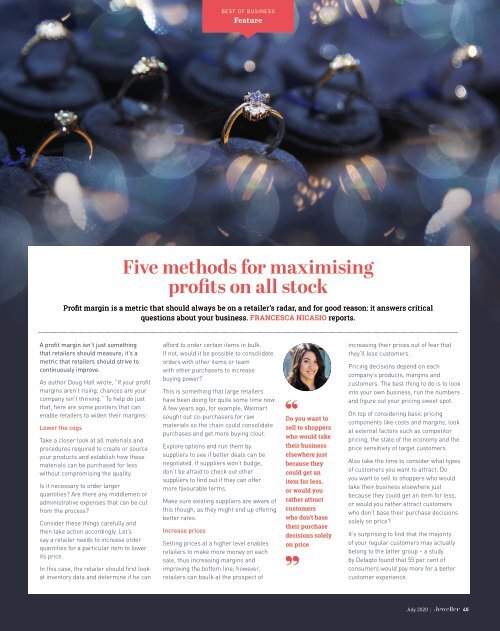Jeweller - July, Edition I 2020
» Talking stock: Simple strategies to maximise profits on your product » Fine resilience: First instalment of the 2020 State of the Industry Report » History lesson: Evolution of jewellery chain stores over the past decade
» Talking stock: Simple strategies to maximise profits on your product
» Fine resilience: First instalment of the 2020 State of the Industry Report
» History lesson: Evolution of jewellery chain stores over the past decade
You also want an ePaper? Increase the reach of your titles
YUMPU automatically turns print PDFs into web optimized ePapers that Google loves.
BEST OF BUSINESS<br />
Feature<br />
Five methods for maximising<br />
profits on all stock<br />
Profit margin is a metric that should always be on a retailer’s radar, and for good reason: it answers critical<br />
questions about your business. FRANCESCA NICASIO reports.<br />
A profit margin isn’t just something<br />
that retailers should measure; it’s a<br />
metric that retailers should strive to<br />
continuously improve.<br />
As author Doug Hall wrote, “If your profit<br />
margins aren’t rising, chances are your<br />
company isn’t thriving.” To help do just<br />
that, here are some pointers that can<br />
enable retailers to widen their margins:<br />
Lower the cogs<br />
Take a closer look at all materials and<br />
procedures required to create or source<br />
your products and establish how these<br />
materials can be purchased for less<br />
without compromising the quality.<br />
Is it necessary to order larger<br />
quantities? Are there any middlemen or<br />
administrative expenses that can be cut<br />
from the process?<br />
Consider these things carefully and<br />
then take action accordingly. Let’s<br />
say a retailer needs to increase order<br />
quantities for a particular item to lower<br />
its price.<br />
In this case, the retailer should first look<br />
at inventory data and determine if he can<br />
afford to order certain items in bulk.<br />
If not, would it be possible to consolidate<br />
orders with other items or team<br />
with other purchasers to increase<br />
buying power?<br />
This is something that large retailers<br />
have been doing for quite some time now.<br />
A few years ago, for example, Walmart<br />
sought out co-purchasers for raw<br />
materials so the chain could consolidate<br />
purchases and get more buying clout.<br />
Explore options and run them by<br />
suppliers to see if better deals can be<br />
negotiated. If suppliers won’t budge,<br />
don’t be afraid to check out other<br />
suppliers to find out if they can offer<br />
more favourable terms.<br />
Make sure existing suppliers are aware of<br />
this though, as they might end up offering<br />
better rates.<br />
Increase prices<br />
Setting prices at a higher level enables<br />
retailers to make more money on each<br />
sale, thus increasing margins and<br />
improving the bottom line; however,<br />
retailers can baulk at the prospect of<br />
Do you want to<br />
sell to shoppers<br />
who would take<br />
their business<br />
elsewhere just<br />
because they<br />
could get an<br />
item for less,<br />
or would you<br />
rather attract<br />
customers<br />
who don’t base<br />
their purchase<br />
decisions solely<br />
on price<br />
increasing their prices out of fear that<br />
they’ll lose customers.<br />
Pricing decisions depend on each<br />
company’s products, margins and<br />
customers. The best thing to do is to look<br />
into your own business, run the numbers<br />
and figure out your pricing sweet spot.<br />
On top of considering basic pricing<br />
components like costs and margins, look<br />
at external factors such as competitor<br />
pricing, the state of the economy and the<br />
price sensitivity of target customers.<br />
Also take the time to consider what types<br />
of customers you want to attract. Do<br />
you want to sell to shoppers who would<br />
take their business elsewhere just<br />
because they could get an item for less,<br />
or would you rather attract customers<br />
who don’t base their purchase decisions<br />
solely on price?<br />
It’s surprising to find that the majority<br />
of your regular customers may actually<br />
belong to the latter group – a study<br />
by Defaqto found that 55 per cent of<br />
consumers would pay more for a better<br />
customer experience.<br />
<strong>July</strong> <strong>2020</strong> | 45


















